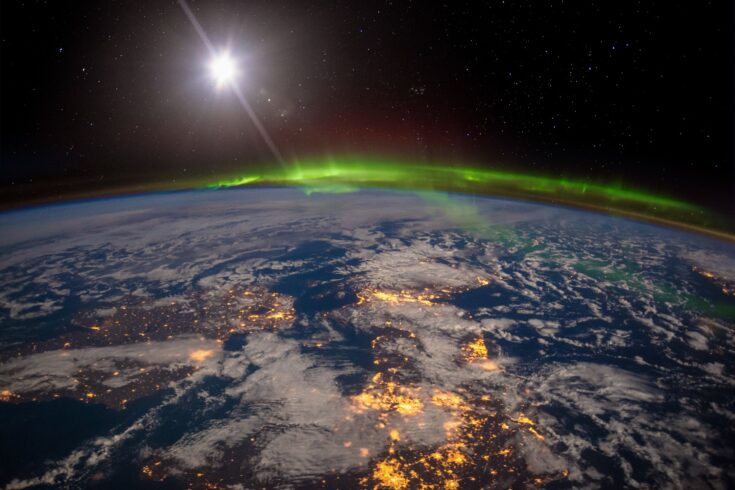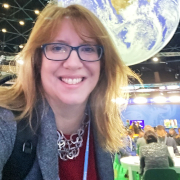You may have heard that the United Nations Climate Change Conference (COP26) took place in Glasgow between 1 and 12 November. It was attended by 40,000 including:
- activists like Greta Thunberg and Leonard Di Caprio
- delegates and politicians from Joe Biden to Boris Johnson
- businesses
- royalty.
What is COP26?
COP26 is a strange name that doesn’t obviously link to climate change. It stands for Conference of the Parties and is the 26th meeting of this group.
There are many conferences of the parties. There is one for biodiversity and non-nuclear proliferation. But this COP is the famous one that comes under the banner of the United Nations Framework Convention on Climate Change.
With a long title like that I would shorten it to COP as well!
UKRI and COP26
I have been working on UK Research and Innovation (UKRI)’s COP26 programme since February this year, working across councils to deliver:
- an innovative exhibition showcase
- virtual platform
- thematic sessions.
These celebrate the work of our brilliant communities to understand climate change and develop the solutions to reduce emissions and achieve net zero.
I had the opportunity to:
- talk to businesses about their sustainability plans
- catch up with academics delivering collaborative activities
- meet with policymakers to shape debates.
However, during the build-up it was impossible to know what the conference would feel like.
A blur of green
The green zone was where UKRI’s main exhibition stand was located and this area of COP26 was focused on public engagement and interaction.
A brilliant collaboration took place between UKRI and GlassFutures (a UKRI investment), with sponsorship and collaboration from:
- Liverpool city region
- Siemens
- Dieagio
- Encirc
- the wider glass community.

Claire Spooner at COP26 (credit: Claire Spooner)
They delivered an innovate glass five-metre by two-metre art installation. It was inspired by the warming stripes, a visual display of climate change and how global temperature increased over the last 100 years. It was developed by Professor Ed Hawkins from the University of Reading.
Research and innovation activities
This was the centrepiece to our exhibition with key academics attending to talk to the public about their amazing research, telling a personal story of their research and innovation activities.
I was lucky enough to have Professor Jim Watson from UCL, Professor David Knowles CEO of the Henry Royce Institute and Professor Serena Cussen from Sheffield all helping at our stand. They were telling the story of their science and explaining their research to the crowds.
And what crowds, approximately 3,000 people attended the green zone every day, keen to engage, discuss and debate the issues of the thematic day.
The theatre of COP
In a giant echoey theatre I was fortunate enough to speak.
An IMAX cinema auditorium was the location for my presentation and a space that could hold 300 people. But it felt big, because this was an in-person meeting and something that I hadn’t experienced at this scale for such a long time.
I was part of a session on how research and innovation is tackling climate change, a small part in a much larger production. I kept focused on the presenter and journalist Lucy Siegle. I was scared to look at the auditorium, focusing on my questions, hoping I made sense to the crowd in the room but also to the audience at home.

Claire Spooner speaking at COP26 (credit: Claire Spooner)
Highlighting investments
It was exciting, talking for UKRI and EPSRC on our activities and highlighting our investments, including:
- UK Energy Research Centre
- Centre for Research into Energy Demand Solutions
- Decarbon8.
I was trying to remember them all, but then it was over. Instantly I was on a different kind of stage, looking after our exhibition stand again. Carrying out short vox pops to camera, talking to the public, sharing this experience, the day turning into a blur, that provided one more highlight. Maggie Philbin, of Tomorrows World fame liked my social media update on the presentation. My life is now complete!
A blue haze
I knew in advance that I would be in the blue zone on transport day where the main discussions with all the VIPs and delegates took place. And I had the opportunity to watch a couple of sessions.
I was looking forward to networking and taking in the atmosphere. What I didn’t expect was to become a last minute substitute speaker. Before I even fully understood what the topic for discussion was to be on, I said yes!
Only on the morning of the panel session did I fully digest the enormity of the opportunity. I was speaking about “batteries and the tipping point for electric vehicle usage”. Earlier in the week, former President Obama had presented there, David Attenbourgh had stood in the same spot, Prime Minister Boris Johnson too…and now me.
I was nervous, really nervous, and then I realised I was presenting with a minister! Minister Nichola Mallon, Minister for Infrastructure, Northern Ireland was chairing this session along with:
- Chief Operating Officer for Hitachi Rail
- Head of Strategy for National Grid
- Electric Vehicle Sector Director for SSE
- …and me.
I am not usually one for self-doubt, but I did pause for just a fraction of a second. But then the session started, to a full UK pavilion with discussions and questions and seemed to last only a fraction of a second.
Reflections
The transport day in the blue zone was my last day at COP26. I am still absorbing all that happened, all the interesting people I met, how well the exhibition stand went, the fact I presented in both zones.
I met Andy Burham, Metro Mayor of Manchester (who knew about the Royce Institute). I missed Prince William visiting our stand. But this was made up for when Steve Rotherham the Metro Mayor of Liverpool invited me to see their transport infrastructure in person next year. I showed our very own Ottoline Leyser UKRI’s exhibition stand, telling a story of collaboration.
I spent six days at COP over the 12 days it took place and worked with some amazing people within and beyond UKRI.
But all the activity I undertook in the run up to COP as well as the vast amount of effort from UKRI builds up to the reason COP took place:
- to negotiate a good, equitable outcome
- to reduce the impacts of climate change
- to deliver a net zero future.
Only time will tell if that fully happens.
Top image: Credit: Elen11, Getty Images




